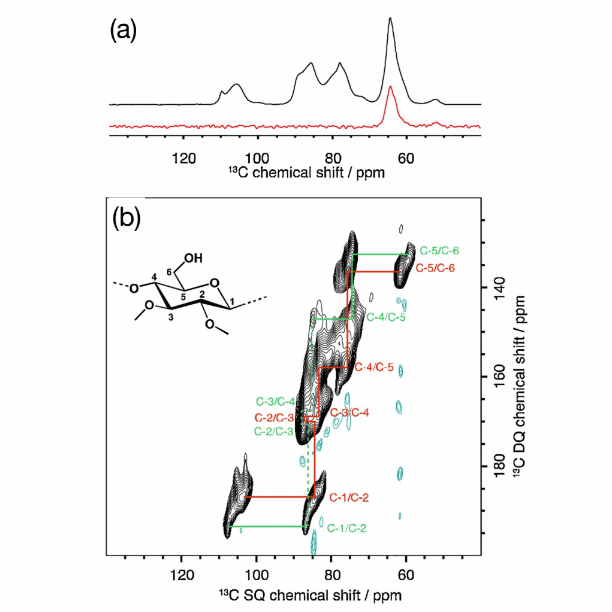Challenge: Understanding the substitution patterns in cellulose ethers is critical for various industrial applications, including the production of polymers and textile materials. Traditional methods for characterizing these substitution sites often lack the necessary precision, particularly at natural isotopic abundance, making it difficult to fully analyze the molecular structure of these compounds.
NMR Solution: Using Dynamic Nuclear Polarization (DNP) enhanced solid-state NMR spectroscopy, academic researchers in collaboration with Nouryon Functional Chemicals and AstraZeneca were able to determine the precise substitution patterns in methylcellulose ethers. Two advanced approaches were introduced to achieve this: 13C-13C correlation experiments and selective CH3 hyperpolarization. These methods were applied to regioselectively substituted methylcellulose ethers, providing clear insights into the substitution sites at the atomic level. The enhanced sensitivity of DNP MAS NMR allowed for the characterization of these compounds at natural abundance, a significant improvement over conventional techniques.
Impact: This innovative use of DNP-enhanced NMR enables the detailed characterization of cellulose ethers, which is essential for industries working with polymers, coatings, and pharmaceuticals. By revealing the precise regioselectivity of the methyl substitutions, these methods offer a new level of control over the functional properties of cellulose-based materials, paving the way for more efficient and tailored production processes. The ability to analyze these patterns with greater accuracy has broad implications for improving the quality and performance of cellulose-derived products.
Key Points for industry:
- Precise Substitution Analysis: DNP-enhanced NMR enables accurate identification of methyl substitution patterns in cellulose ethers, critical for polymer design.
- Advanced NMR Technology: Two new NMR-based methods provide a more detailed understanding of regioselective substitutions, supporting better material performance.
- Broad Industrial Relevance: These findings have applications across multiple industries, including textiles, coatings, and pharmaceuticals, allowing for optimized material properties.
Reference: Berruyer, P.; Gericke, M.; Moutzouri, P.; Jakobi, D.; Bardet, M.; Karlson, L.; Schantz, S.; Heinze, T.; Emsley, L. Advanced Characterization of Regioselectively Substituted Methylcellulose Model Compounds by DNP Enhanced Solid-State NMR Spectroscopy. Carbohydr. Polym. 2021, 262, 117944.
https://doi.org/10.1016/j.carbpol.2021.117944

Figure: (a) 1H-13C DNP CPMAS NMR spectrum (black) and 1H-13C DNP CPMAS NMR spectrum with CH3 selection (red), and (b) 13C-13C DNP CP-refocused-INADEQUATE NMR spectrum of 2,3-O-dimethylcellulose impregnated with 10 mM AMUPOL in D2O/H2O, at 10 kHz MAS and at ca. 100 K.
Reprinted from Berruyer et al, Carbohydr. Polym. 2021, 262, 117944. Licensed under Creative Commons Attribution 4.0 International License (CC BY 4.0).





